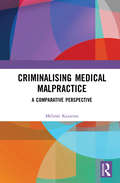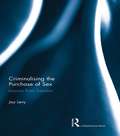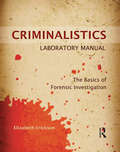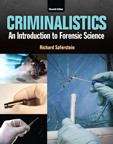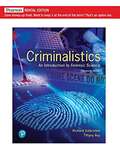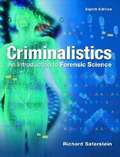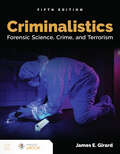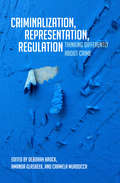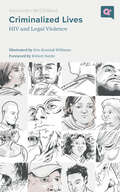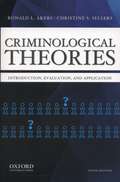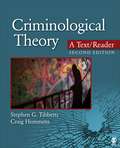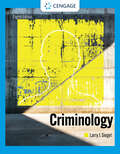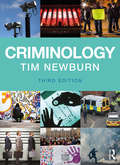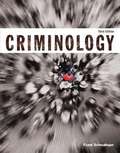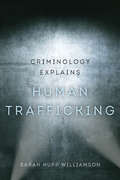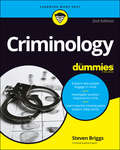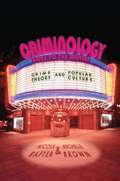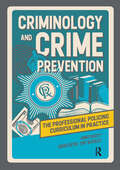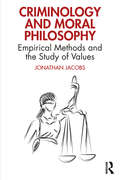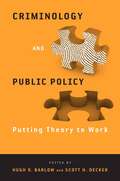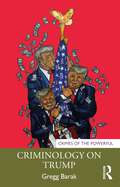- Table View
- List View
Criminalising Hate: Law as Social Justice Liberalism (Palgrave Hate Studies)
by Mark Austin WaltersThis book presents both a new theoretical framework for the criminalisation of hate, referred to as “law as social justice liberalism”, and a comprehensive analysis of hate crime laws that have been enacted globally. The book begins by reflecting back on 30 years of theorisation on hate crime laws, arguing that there has been a failure to adequately capture the distinct harms of hate-based criminal conduct within legal frameworks. The book posits that liberal societies interested in advancing social equality ought to expand conventional paradigms of harm used in criminal law by comprehending hate-based conduct as a form of social injustice. Drawing on the work of Iris Young, the book sets out a comprehensive analysis of the harms of hate crime as a form of group-based oppression and uses this to set out criteria for the inclusion of protected characteristics under legislation.The second half of the book presents findings from a comparative study of hate crime laws enacted in 190 different legal jurisdictions. This includes a new taxonomy of types, models and legal tests used by legislatures to capture the myriad forms of hate-based criminal conduct that occur globally. Further evaluation of case law and empirical research on the application of these diverging legislative approaches is used to provide recommendations on how legislators ought to construct hate crime laws. The book completes its analysis of law as social justice liberalism by synthesising law, punishment and restorative justice as a means of ensuring that liberal systems of “justice” are more firmly anchored to the advancement of “social justice”.
Criminalising Medical Malpractice: A Comparative Perspective
by Mélinée KazarianThe criminalisation of healthcare malpractice has become a highly topical and somewhat controversial question in recent years. Studies have demonstrated that in England and Wales, the trend towards holding healthcare professionals to account for malpractice is rapidly growing, abolishing the deference doctors enjoyed decades ago. The changing attitude of judges to claims for clinical negligence has been well documented. The role of the criminal process in England and Wales has been less fully analysed with the criminal law playing a very limited role until recently in the regulation of poor healthcare practice. In contrast, in France, the criminal process has for a long time been invoked more readily to respond to cases of healthcare malpractice, which involved even mere errors. This book compares English and French criminal law responses to healthcare malpractice and considers what lessons the French model can provide for potential reform in England and elsewhere. The book takes the HIV-contaminated blood episode as a primary example of the different approaches France and England have in dealing with healthcare malpractice. Kazarian emphasises the impact of rules of substantive criminal law and criminal procedure on the way in which healthcare malpractice is criminalised in a given country. This book explores the key lessons to be drawn on whether the criminal process is an appropriate means to respond to instances of healthcare malpractice. It proposes that features of French criminal law and criminal procedure might be useful to counteract healthcare malpractice.
Criminalising the Purchase of Sex: Lessons from Sweden
by Jay LevyIn an attempt to abolish prostitution, Sweden criminalised the purchase of sex in 1999, while simultaneously decriminalising its sale. In so doing, it set itself apart from other European states, promoting itself as the pioneer of a radical approach to prostitution. What has come to be referred to as ‘the Swedish model’ has been enormously influential, and has since been adopted and proposed by other countries. This book establishes the outcomes of this law – and the law’s justifying narratives – for the dynamics of Swedish sex work, and upon the lives of sex workers. Drawing on recent fieldwork undertaken in Sweden over several years, including qualitative interviewing and participant observation, Jay Levy argues that far from being a law to be emulated, the Swedish model has had many detrimental impacts, and has failed to demonstrably decrease levels of prostitution. Criminalising the Purchase of Sex: Lessons from Sweden utilises a wealth of respondent testimony and secondary research to redress the current lack of primary academic research and to contribute to academic discussion on this politically-charged and internationally relevant topic. This original and timely work will be of interest to sex worker rights organisations, policy makers and politicians, as well as researchers, academics and students across a number of related disciplines, including law, sociology, criminology, human geography and gender studies.
Criminalistics Laboratory Manual: The Basics of Forensic Investigation
by Elizabeth EricksonThe Criminalistics Laboratory Manual: The Basics of Forensic Investigation provides students with little to no prior knowledge of forensic science with a practical crime scene processing experience. The manual starts with an original crime scene narrative setting up the crime students are to solve. This narrative is picked up in each of the forensic science lab activities, tying each forensic discipline together to show the integrated workings of a real crime lab. After the completion of all of the exercises, the student will be able to solve the homicide based on forensic evidence.
Criminalistics: An Introduction to Forensic Science
by Richard SafersteinThis best-selling text, written for the non-scientist, is appropriate for a wide variety of students, including criminal justice, law enforcement, law, and more! Criminalistics: An Introduction to Forensic Science, 11e, strives to make the technology of the modern crime laboratory clear and comprehensible to the non-scientist. The nature of physical evidence is defined, and the limitations that technology and current knowledge impose on its individualization and characterization are examined. By combining case stories with applicable technology, Criminalistics endeavors to capture the pulse and fervor of forensic science investigations. A major portion of the text centers on discussions of the common items of physical evidence encountered at crime scenes. These chapters include descriptions of forensic analysis, as well as updated techniques for the proper collection and preservation of evidence at crime scenes. Particular attention is paid to the meaning and role of probability in interpreting the evidential significance of scientifically evaluated evidence.
Criminalistics: An Introduction to Forensic Science
by Richard Saferstein Tiffany RoyA clear introduction to the technology of the modern crime laboratory for non-scientists <p><p>Criminalistics: An Introduction to Forensic Science uses clear writing, case studies, and modern technology to reveal the essence of forensic science. The text aims to make the subject of forensic science clear and comprehensible to a wide variety of readers, from future forensic scientists to those curious about the subject. The nature of physical evidence is defined, and the limitations that technology and current knowledge impose on its individualization and characterization are examined. <p><p>Updated throughout, the 13th Edition includes new information on interpreting blood stain patterns, genotyping, and bite mark comparison.
Criminalistics: An Introduction to Forensic Science (8th Edition, College Version)
by Richard SafersteinThe text covers the comprehensive realm of forensics and its role in criminal investigations. Physical evidence collection and preservation techniques are examined in detail including chapters on Computer Forensics and DNA.
Criminalistics: Forensic Science, Crime, and Terrorism
by James E. GirardCriminalistics continues to set the standard for modern forensic methods and investigative techniques in a new, updated fifth edition. Beginning at the crime scene and proceeding to the forensic laboratory, the text walks the reader through the entire forensic investigation. Students learn how to accurately identify, gather, and analyze multiple types of evidence by examining actual crimes that were solved using the techniques presented. The Fifth Edition features new contemporary case studies and updated statistics. Also, the section about terrorism has been updated and expanded to include important terrorism-related topics: agroterrorism, the forensic analysis of internet data, cyberterrorism, explosives, weapons of mass destruction, and the techniques used to identify them. The most comprehensive and accessible text of its kind, Criminalistics: Forensic Science, Crime, and Terrorism, Fifth Edition is a practical, student-friendly introduction to this exciting science.
Criminality and Criminal Justice in Contemporary Poland: Sociopolitical Perspectives
by Konrad Buczkowski Beata Czarnecka-Dzialuk Witold Klaus Anna Kossowska Irena Rzepli?ska Dagmara Wo?niakowska-Fajst Dobrochna WójcikCriminality has accompanied social life from the outset. It has appeared at every stage of the development of every community, regardless of organisation, form of government or period in history. This work presents the views of criminologists from Central Europe on the phenomenon of criminality as a component of social and political reality. Despite the far advanced homogenisation of culture and the coming together of the countries that make up the European Union, criminality is not easily captured by statistics and simple comparisons. There can be huge variation not only on crime reporting systems and information on convicts but also on definitions of the same crimes and their formulations in the criminal codes of the individual European countries. This book fills a gap in the English-language criminological literature on the causes and determinants of criminality in Central Europe. Poland, as the largest country in the region, whose political post-war path has been similar to the other countries in this part of Europe, is subject to an exhaustive and original look at criminality as part of the political and social reality. The authors offer a contribution to the debate in the social and criminal policy of the state over the problems of criminality and how to control it.
Criminalization, Representation, Regulation: Thinking Differently About Crime
by Deborah Brock Amanda Glasbeek Carmela MurdoccaWhat is a crime and how do we construct it? The answers to these questions are complex and entangled in a web of power relations that require us to think differently about processes of criminalization and regulation. This book draws on Foucault's concept of governmentality as a lens to analyze and critique how crime is understood, reproduced, and challenged. It explores the dynamic interplay between practices of representation, processes of criminalization, and the ways that these circulate to both reflect and constitute crime and "justice."
Criminalized Lives: HIV and Legal Violence (Q+ Public)
by Alexander McClellandCanada has been known as a hot spot for HIV criminalization where the act of not disclosing one’s HIV-positive status to sex partners has historically been regarded as a serious criminal offence. Criminalized Lives describes how this approach has disproportionately harmed the poor, Black and Indigenous people, gay men, and women in Canada. In this book, people who have been criminally accused of not disclosing their HIV-positive status, detail the many complexities of disclosure, and the violence that results from being criminalized. Accompanied by portraits from artist Eric Kostiuk Williams, the profiles examine whether the criminal legal system is really prepared to handle the nuances and ethical dilemmas faced everyday by people living with HIV. By offering personal stories of people who have faced criminalization first-hand, Alexander McClelland questions common assumptions about HIV, the role of punishment, and the violence that results from the criminal legal system’s legacy of categorizing people as either victims or perpetrators. Note: A regrettable error appears on page 22. The number 240 should be 206 when referring to the number of people prosecuted in relation to allegations of HIV nondisclosure. This will be fixed in future reprints.
Criminological Approaches to International Criminal Law
by Ilias Bantekas Emmanouela MylonakiThis volume is one of the few books to explain in-depth the international crimes behind the scenes of substantive or procedural law. The contributors place a particular focus on what motivates participation in international crime, how perpetrators, witnesses and victims see their predicament and how international crimes should be investigated at local and international level, with an emphasis on context. The book engages these questions with a broad interdisciplinary approach that is accessible to both lawyers and non-lawyers alike. It discusses international crime through the lens of anthropology, neuroscience, psychology, state crime theory and information systems theory and draws upon relevant investigative experience from experts in international and domestic law prosecutions.
Criminological Theories: Introduction, Evaluation, and Application
by Wesley G. Jennings Ronald L. Akers Christine S. SellersIn Criminological Theories: Introduction, Evaluation, and Application, Eighth Edition, Ronald L. Akers, Christine S. Sellers, and Wesley G. Jennings provide a concise but thorough review and appraisal of the leading theories of crime and criminal justice. Based on the widespread success of the first seven editions, this landmark book keeps current with changes in the development, testing, integration, and application of important criminological theories. Each chapter has been updated and substantially revised in light of recent research and important changes in the theories. More extensive revision and updating have been done on biological and biosocial, psychological, social disorganization, and conflict theories.
Criminological Theories: Introduction, Evaluation, and Application
by Ronald Akers Christine SellersWith a focus on empirical evaluation and practical application, Criminological Theories: Introduction, Evaluation, and Application, Sixth Edition, helps students draw connections between criminological theory and practical applications. In clear, engaging language, authors Ronald L. Akers and Christine S. Sellers explore each principal criminological theory using a three-part analysis: * An Introduction presents a succinct exposition of the theory's central concepts, assertions, and hypotheses. * Next, an Evaluation provides a detailed critique of the theory, with an emphasis on empirical validity. * Finally, an Application extends the evaluation to determine each theory's relevance, as well as its potential for controlling and preventing crime and delinquency. Companion Website.
Criminological Theory: A Text/Reader (Second Edition)
by Stephen G. Tibbetts Craig HemmensThe most accessible and comprehensive book for criminological theory courses available today, Criminological Theory: A Text/Reader, Second Edition, by Stephen G. Tibbetts and Craig Hemmens, provides the best of both worlds―substantial but brief authored sections on all of the major course topics, followed by carefully edited, policy-oriented, original research articles covering criminological theory from past to present and beyond. The Second Edition’s dozens of articles reflect both classic studies and state-of-the-art research. Designed throughout to enhance understanding, the book includes a helpful "How to Read a Research Article" before the first reading, as well as article introductions, photographs, and discussion questions that capture reader interest and help them develop their critical thinking skills. The new 2nd edition has added 8 new readings that are more recent and applicable to theoretical models in the text.
Criminology
by Larry J. SiegelWritten by bestselling author Larry Siegel, CRIMINOLOGY, 8th Edition, guides you through the fast-paced field of modern criminology, its most current research and fascinating examples that help you understand criminological theory. Details on the crimes of real-life people illustrate concepts, while unbiased coverage of even the most controversial topics -- ranging from responses to sexual assault on campus to cybercrime -- enables you to form your own opinions about current issues and events. The 8th edition offers insights into racial bias, political crime, terrorism, green-collar crime, ransomware attacks, human trafficking, the impact of the COVID-19 pandemic and more. Features such as "Crime of the Century" provide in-depth discussions of notorious crimes that captivated the public and shaped the way we view the true meaning of justice. Also available: MindTap digital learning solution.
Criminology
by Tim NewburnComprehensive and accessible, Tim Newburn’s bestselling?Criminology?provides an introduction to the fundamental themes, concepts, theories, methods and events that underpin the subject and form the basis for all undergraduate degree courses and modules?in Criminology and Criminal Justice. This third edition includes: A new chapter on politics, reflecting the ever increasing coverage of political influence and decision making on criminology courses New and updated crime data and analysis of trends, plus new content on recent events such as the Volkswagen scandal, the latest developments on historic child abuse, as well as extended coverage throughout of the English riots A fully revised and updated companion website, including exam, review and multiple choice questions, a live Twitter feed from the author providing links to media and academic coverage of events related to the concepts covered in the book, together with links to a dedicated textbook Facebook page Fully updated to reflect recent developments in the field and extensively illustrated, this authoritative text, written by a leading criminologist and experienced lecturer, is essential reading for all students of Criminology and related fields.
Criminology (Justice Series)
by Frank J. SchmallegerCriminology provides an affordable, thought-provoking look at criminology that uses clear writing and eye-catching visuals to get your students straight to the important concepts. By focusing on the core concepts, students will gain true understanding of the material, without becoming overwhelmed with unnecessary information. The book's conversation-starting pedagogy encourages active participation in learning, moving students beyond memorization by engaging them in the latest research findings and current events shaping the field. <P><P> The Fourth Edition includes updated statistics, an entirely new chapter on victims and victimization, revised Learning Outcomes, and new Putting Criminology to Work boxes which examine evidence-based evaluations of a number of important crime prevention programs.
Criminology Explains Human Trafficking (Criminology Explains #3)
by Sarah Hupp WilliamsonCriminology Explains Human Trafficking provides a comprehensive and accessible overview of criminological theory as it applies to the topic of human trafficking. Sarah Hupp Williamson uses real-life applications and case studies to highlight the connections between theory, research, and policy. She applies a diverse range of criminological theory to cover different forms of trafficking, victims versus offenders, the role of migration and globalization, domestic and international law, anti-trafficking efforts, and more. Through the use of discussion questions, activities, and policy boxes, students come away with a deeper understanding of theory as it applies to the field of human trafficking, including how various levels of analysis from the local to the global are often linked.
Criminology For Dummies
by Steven BriggsExplore the world of crime and punishment Police, forensics, and detective stories dominate our TV screens and bookshelves—from fictional portrayals such as Silence of the Lambs and Law and Order to lurid accounts of real-life super-criminals like Pablo Escobar and Al Capone. As well as being horribly fascinating, knowledge of what makes criminals tick is crucial to governments, who spend billions of dollars each year trying to keep their people safe. Criminology brings disciplines like psychology, biology, and economics together to help police and society solve crimes—and to prevent them before they even happen. The new edition of Criminology For Dummies shines a light into the dark recesses of the criminal mind and goes behind-the-scenes with society’s response to crime, putting you right on the mean streets with cops and criminals alike. Along the way, you’ll learn everything a rookie needs to survive, including basic definitions of what a crime is and how it’s measured; common criminal motivations, thinking, and traits; elementary crime-solving techniques; the effects on and rights of victims; and more. Understand types of crime, from white-collar to organized to terror attacks Follow law-enforcement officials and agencies as they hunt the bad guys Meet key players in criminal justice and see how and why the guilty are punished Check out jobs in the field Whether you plan to enter the criminal justice field or just want to know more about what turns some people to the dark side—and how the thin blue line fights back—this is your perfect guide to criminology basics.
Criminology Goes to the Movies: Crime Theory and Popular Culture
by Nicole Rafter Michelle BrownA &“deftly written and absorbing&” look at how films reflect concepts in criminology and affect our perceptions of criminal behavior (Richard Rosenfeld, coauthor of Crime and the American Dream). From Psycho to Double Indemnity to Thelma & Louise, Nicole Rafter and Michelle Brown show that criminological theory is produced not only in the academy through scholarly research, but also in popular culture through film. Criminology Goes to the Movies connects with ways in which students are already thinking criminologically through engagements with popular culture, encouraging them to use the everyday world as a vehicle for theorizing and understanding both crime and perceptions of criminality. The first work to bring a systematic and sophisticated criminological perspective to bear on crime films, Rafter and Brown&’s book provides a fresh way of looking at cinema using the concepts and analytical tools of criminology to uncover previously unnoticed meanings in film, ultimately making the study of criminological theory more engaging and effective for students while simultaneously demonstrating how theories of crime circulate in our mass-mediated worlds. With chapters focusing on films including Do the Right Thing, Capturing the Friedmans, and more, the result is an illuminating new way of seeing movies and a delightful way of learning about criminology.
Criminology and Crime Prevention (The Professional Policing Curriculum in Practice)
by James DicketyThis book guides policing students through the areas of Criminology and crime prevention required for their course and help them apply this knowledge into their work.It uses crime prevention theory alongside current practice and evidence-based policing research that students can apply in their practice. It explores what criminology is, its helpfulness in policing, and examines key topics such as offenders and offending, victims and victimology, and principles and theories of crime prevention. A range of models of policing which can be applied to various crime prevention scenarios are discussed, with details on specific initiatives already in place. The content is specifically designed to meet the requirements of the PEQF (Police Education Qualifications Framework) and module six in the policing curriculum on criminology and crime prevention.Case studies and evidence-based examples are used to provide clear links between theory and practice, while critical thinking and review activities embed understanding and promote critical thinking. As part of the series, care has been taken into this book to make sure that it reflects challenges faced by new students, linking theory to real-life operational practice.Part of the Professional Policing Curriculum in Practice series.
Criminology and Moral Philosophy: Empirical Methods and the Study of Values
by Jonathan JacobsThe book examines some of the most important forms of normativity and the relation between facts and values in the context of criminological investigation. In recent decades numerous criminologists have argued that criminology needs to be more explicitly concerned with normative considerations and with morality and this book explains the plausibility of that view and of empirically rigorous non-positivist study of moral values. Hume is often regarded as a key figure in separating facts from values and he was a formidable opponent of moral rationalism. Yet, in his own moral philosophy he sought to explicate the genuineness and authority of moral considerations without endorsing some implausible positivist interpretations of a putative fact/value distinction. The significance of Hume’s view and its implications for the empirical study of morality are explored. The book discusses several layers of normativity explored by criminological investigation including: The relation between law and morality the concept of the Rule of Law the normativity of the notion of criminality the justification of sanction the presence and significance of moral considerations This book will be of interest to students taking upper-level courses on criminal justice ethics, punishment, political theory, jurisprudence, and social philosophy.
Criminology and Public Policy: Putting Theory to Work
by Scott H. Decker Hugh D. BarlowCrime policy ought to be guided by science rather than ideology, argue Hugh Barlow and Scott Decker in this incisive and original collection of essays. Establishing the value and importance of linking theory and practice, the contributors to Criminology and Public Policy provide a comprehensive treatment of the major theories in criminology and their implications for criminal justice, crime control, and the larger realm of justice. In applying theories to real world issues--such as reducing crime and violence, prisoner reentry policies, gang behavior, and treatment courts--the contributors take both a macro and micro level approach. They find, too, that it is often difficult to turn theory into practice. Still, the very attempt pushes the criminal justice system toward workable solutions rather than ideological approaches, an orientation the editors believe will lead to greater progress in combating one of our society's greatest difficulties. Contributors include: Robert Agnew, Ronald L. Akers, Gordon Bazemore, Ronald V. Clarke, J. Heith Copes, Frank Cullen, Marcus Felson, Marie Griffin, Scott Jacques, David Kauzlarich, Jean McGloin, Steven Messner, Alex Piquero, Nicole Leeper Piquero, Nancy Rodriguez, Richard B. Rosenfeld, Dawn Rothe, Andrea Schoepfer, Neal Shover, Cassia Spohn, Katherine Tellis, Charles Tittle, Richard Wright, and the editors.
Criminology on Trump (Crimes of the Powerful)
by Gregg BarakCriminology on Trump is a criminological investigation of the world’s most successful outlaw, Donald J. Trump. Over the course of five decades, Donald Trump has been accused of sexual assault, tax evasion, money laundering, non-payment of employees, and the defrauding of tenants, customers, contractors, investors, bankers, and charities. Yet, he has continued to amass wealth and power. In this book, criminologist and social historian Gregg Barak asks why and how?This book examines how the United States precariously maintains stability through conflict in which groups with competing interests and opposing visions struggle for power, negotiate rule breaking, and establish criminal justice. While primarily focused on Trump’s developing character over three quarters of a century, it is also an inquiry into the changing cultural character and social structure of American society. It explores the ways in which both crime and crime control are socially constructed in relation to a changing political economy.An accessible and compelling read, this book is essential for all those who seek a criminological understanding of Donald Trump’s rise to power.

